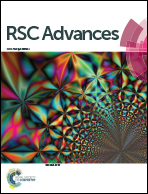Mechanism study on the photocatalytic efficiency enhancement of MoS2 modified Zn–AgIn5S8 quantum dots
Abstract
In this work, colloidal quantum dots (QDs) of environmentally friendly multinary semiconductor Zn–AgIn5S8 are used for heterostructure photocatalysts with hydrothermally deposited MoS2 focusing on the mechanism study of charge transfer processes in the photocatalytic system. The influence of MoS2 is systematically investigated on the structure, optical properties and photocatalytic activity of the Zn–AgIn5S8/MoS2 nanocomposites, where the compromise of the catalytic activity and light shielding effect and increased stability is observed with increasing MoS2. The optimized Zn–AgIn5S8/MoS2-5% composite exhibits high photocatalytic activity for nearly complete degradation of Rhodamine B within 4 min under visible light irradiation. The composite photocatalysts also show good activity on degradation of other organic pollutants including a colorless antibiotic, tetracycline. Photocatalytic mechanism study proves that the main oxidizing species is the superoxide radical formed by the reaction of photogenerated electrons and oxygen molecules, for which MoS2 mainly acts as a cocatalyst that promotes the electron transfer from the Zn–AgIn5S8 QDs. Time-resolved photoluminescence spectroscopy further reveals the increased charge separation by MoS2 from the photoluminescence quenching and lifetime decrease of the QDs, especially that of the long-lived trap states. Moreover, more efficient charge transfer from the dyes is also observed with Zn–AgIn5S8/MoS2, which is distinctively different from that with the Zn–AgIn5S8 QDs, indicating stronger interaction between the dye and photocatalyst with the introduction of MoS2. Based on these results, a continuous charge flow mechanism is proposed, where the electron transfer can be promoted by MoS2 not only from the QDs but also from the dyes that are all converted to superoxide radicals and contributed to the photocatalytic activity increase.


 Please wait while we load your content...
Please wait while we load your content...